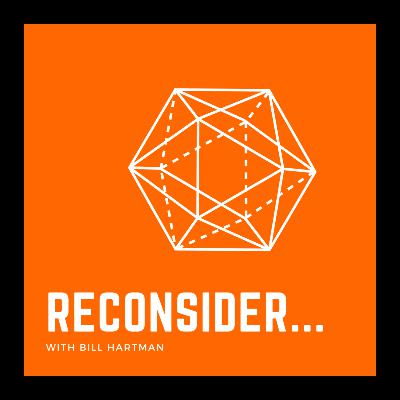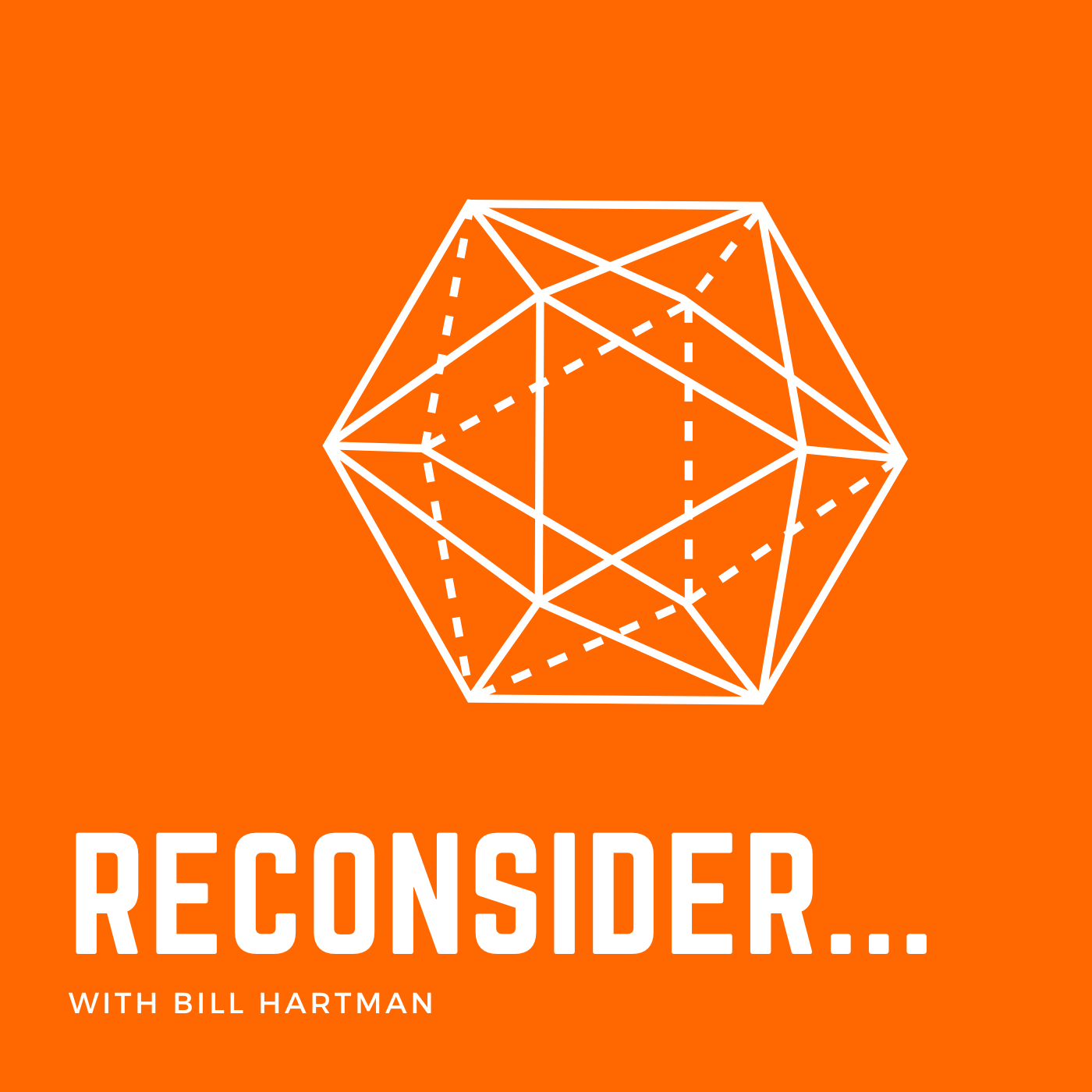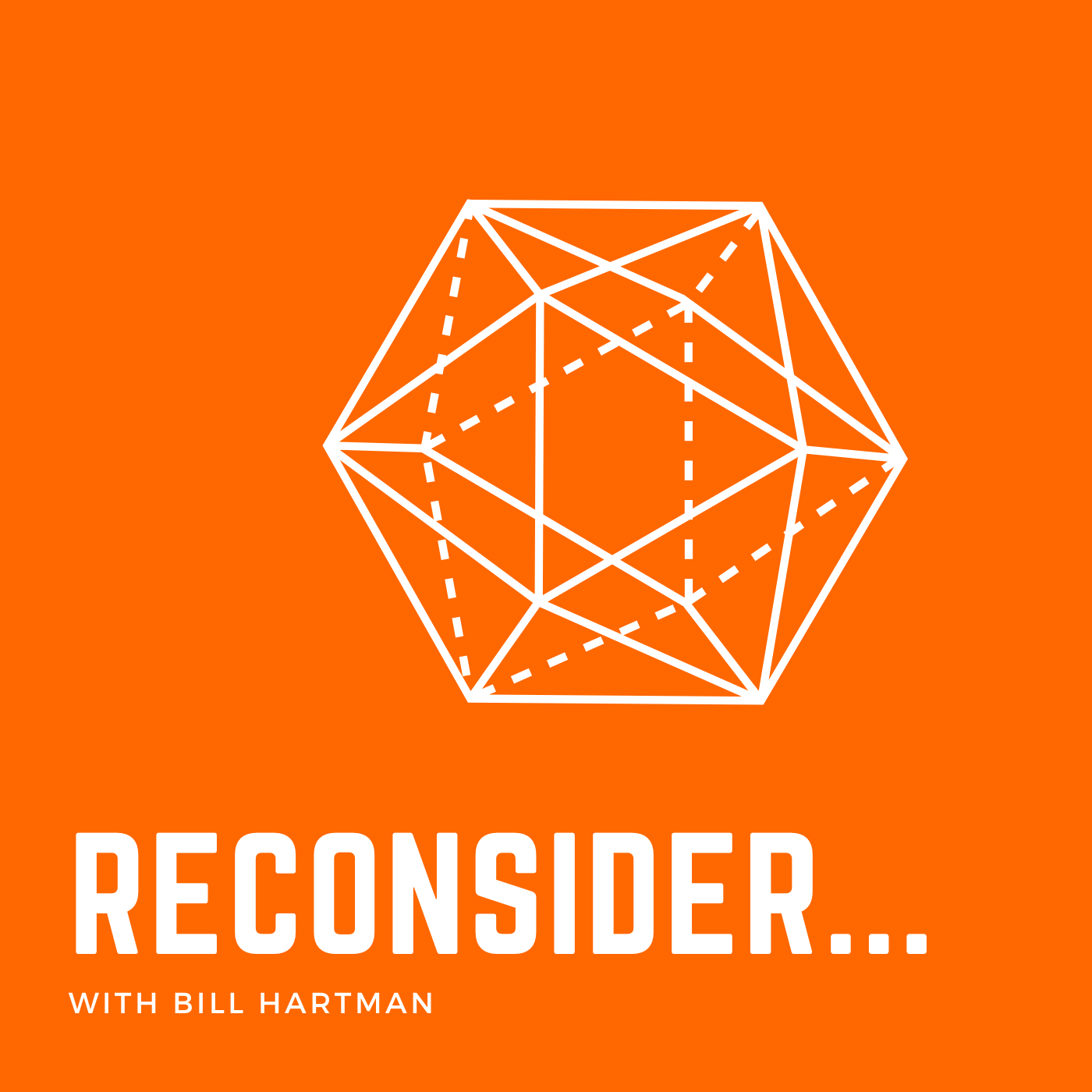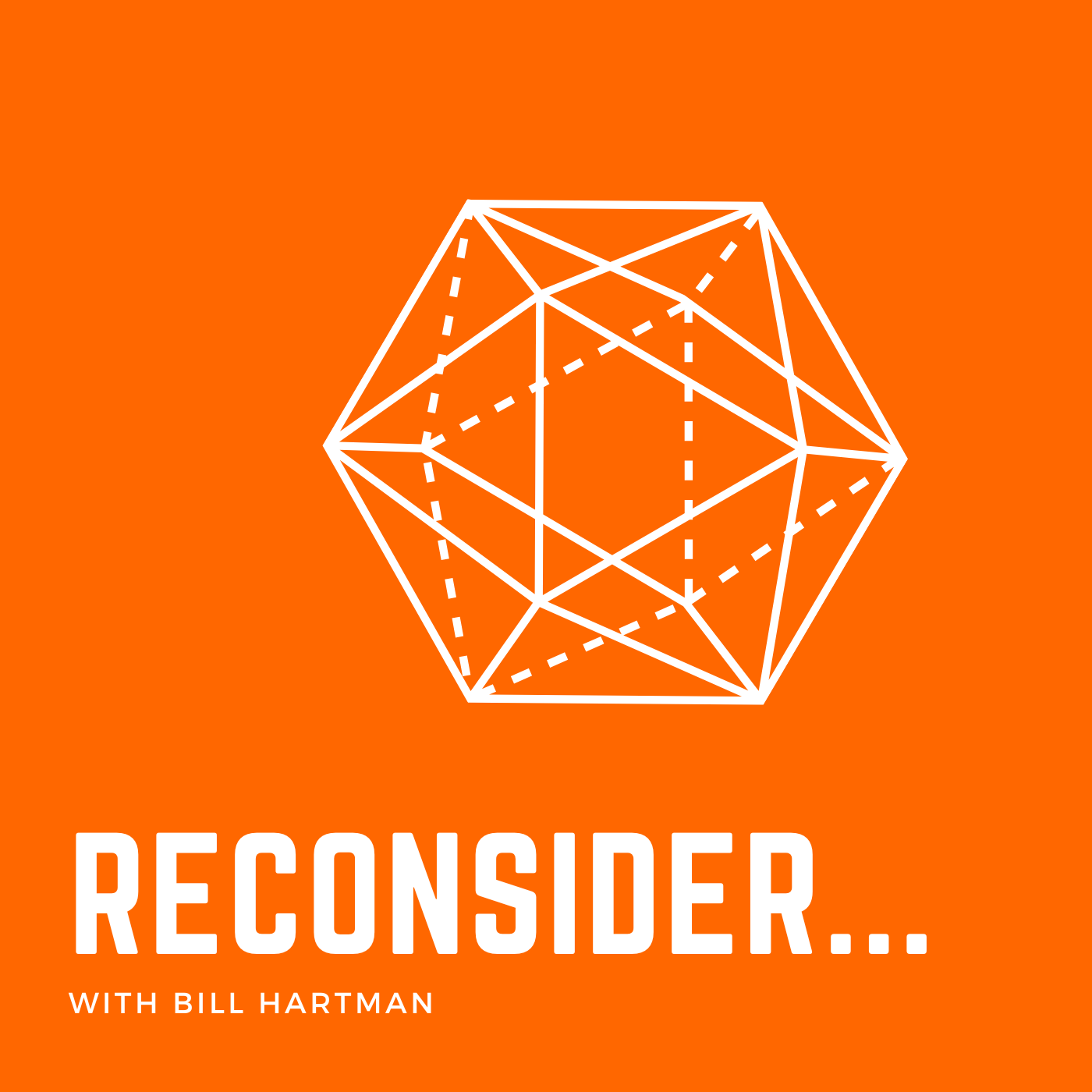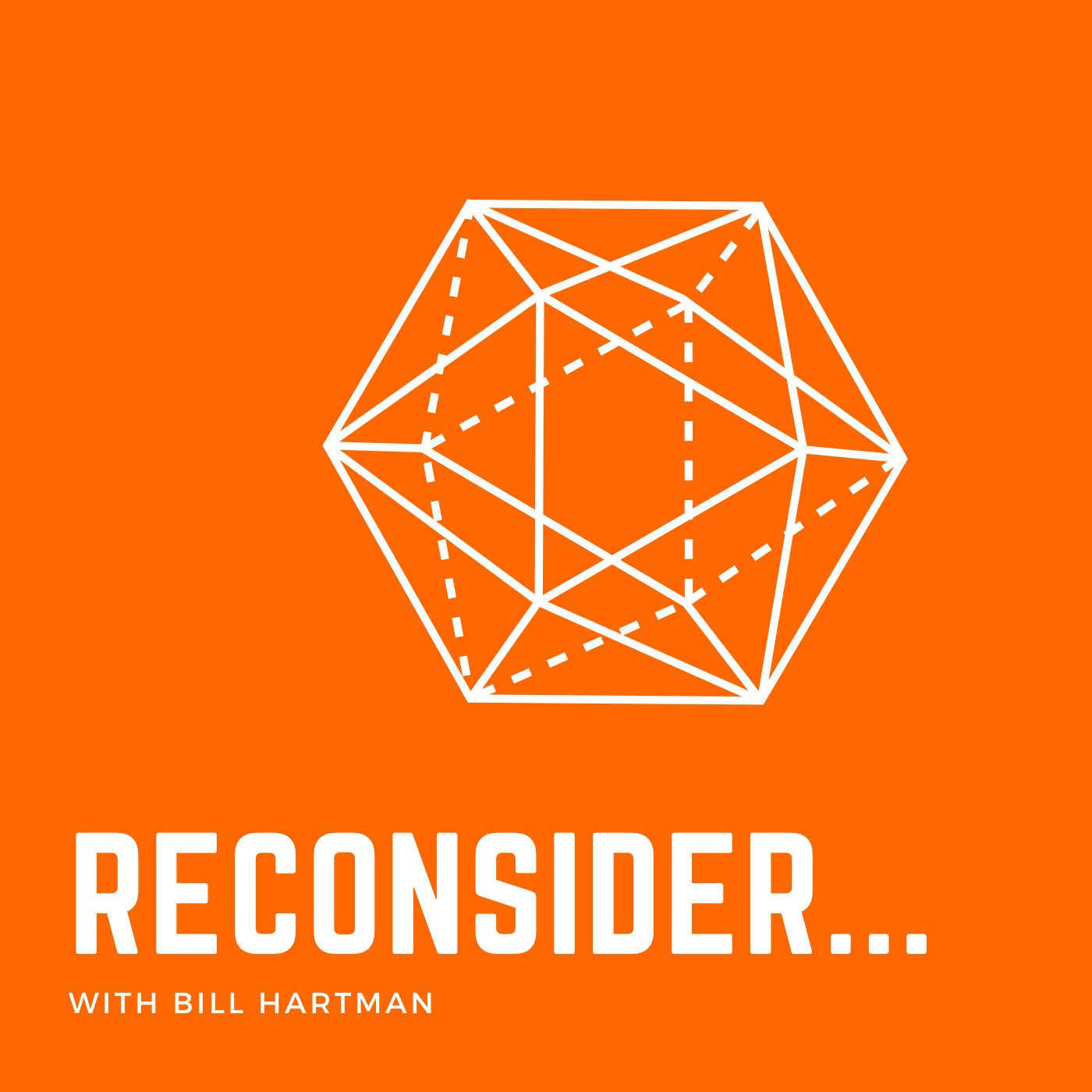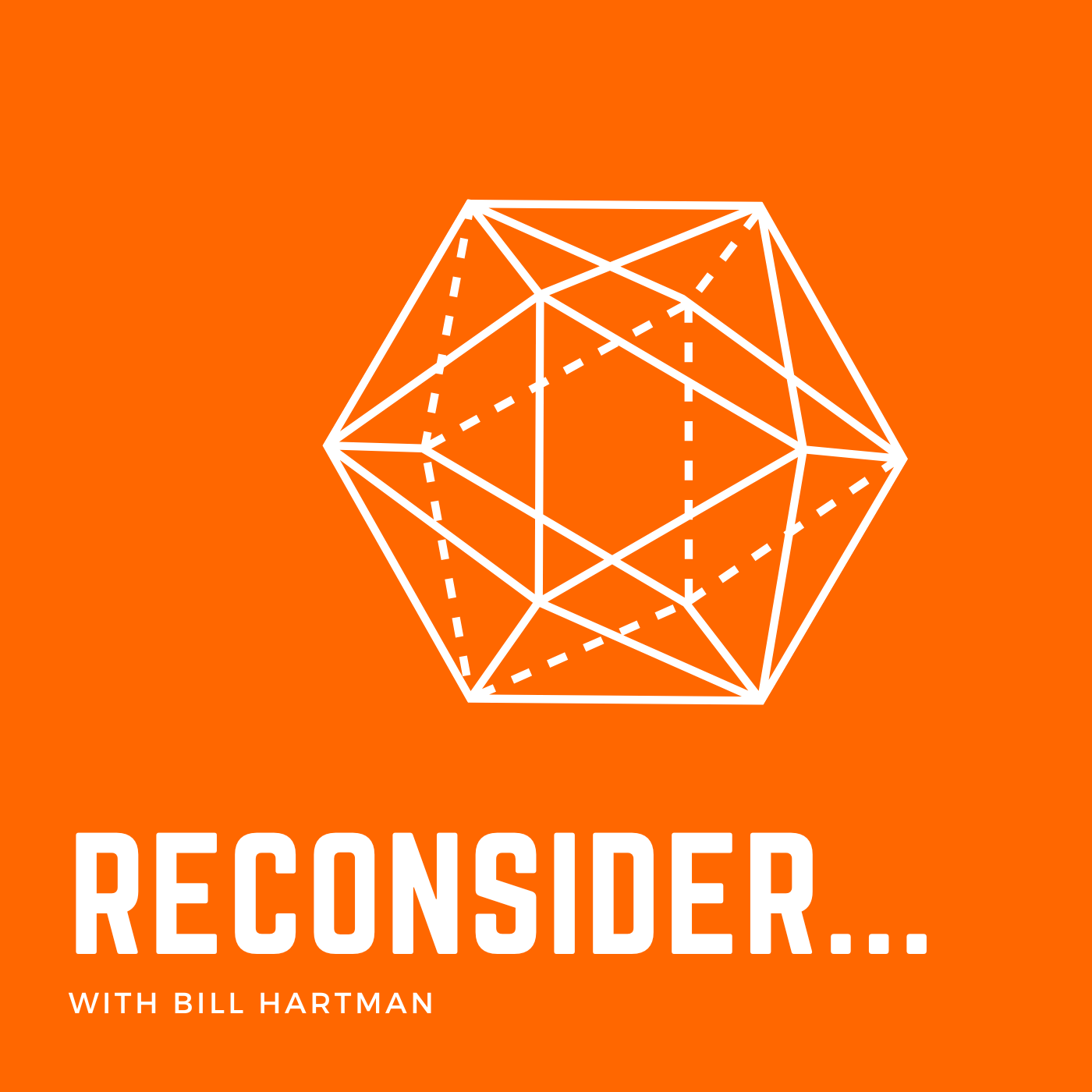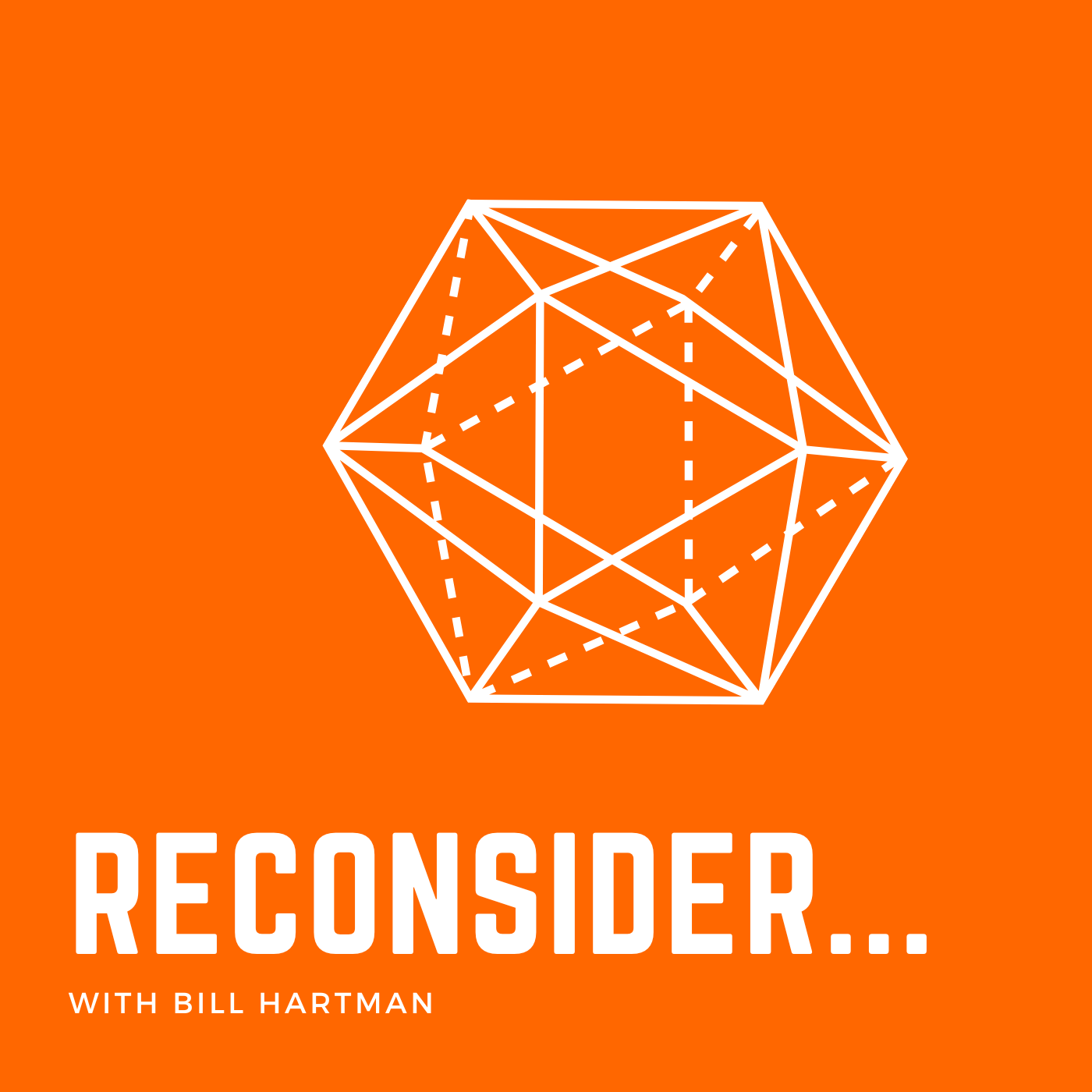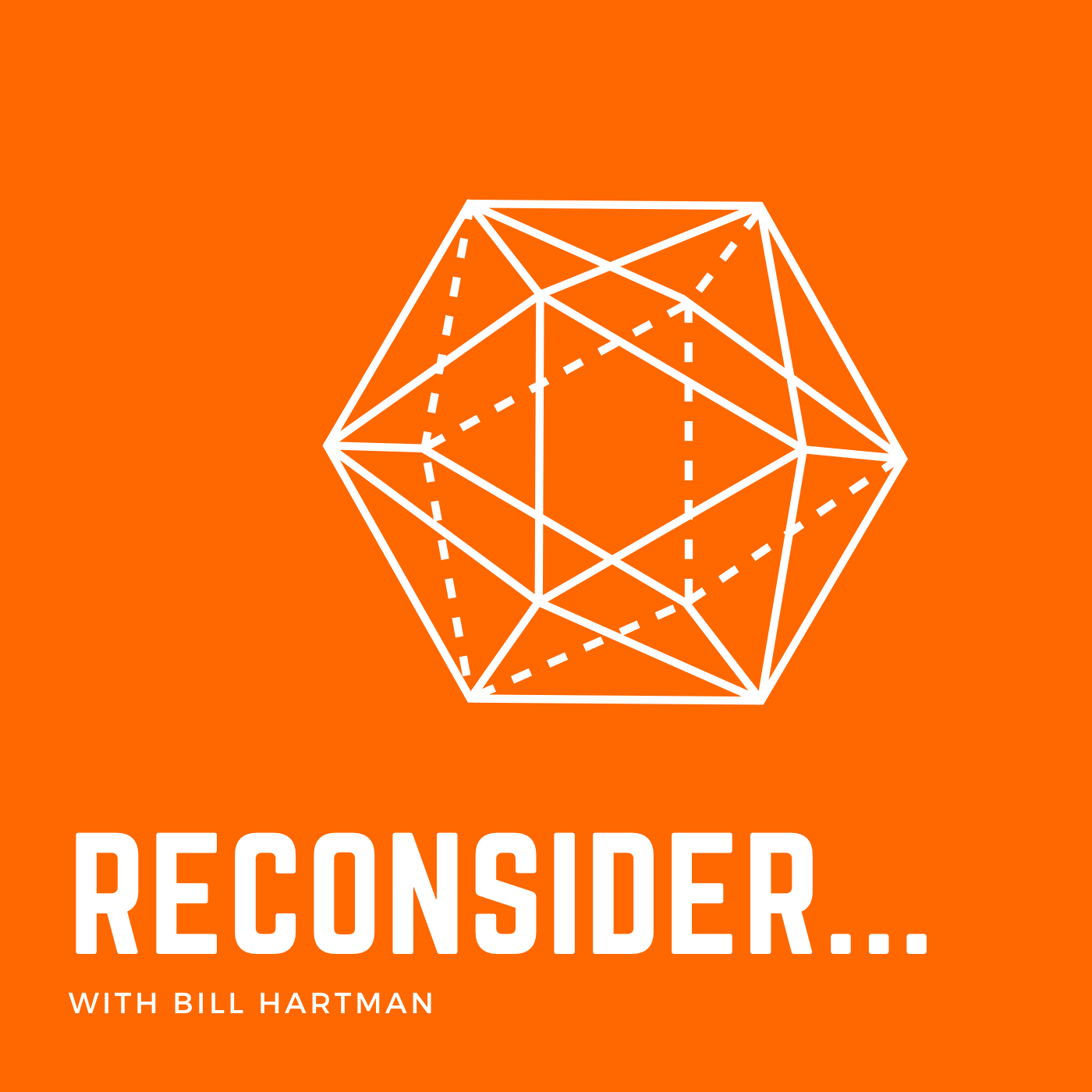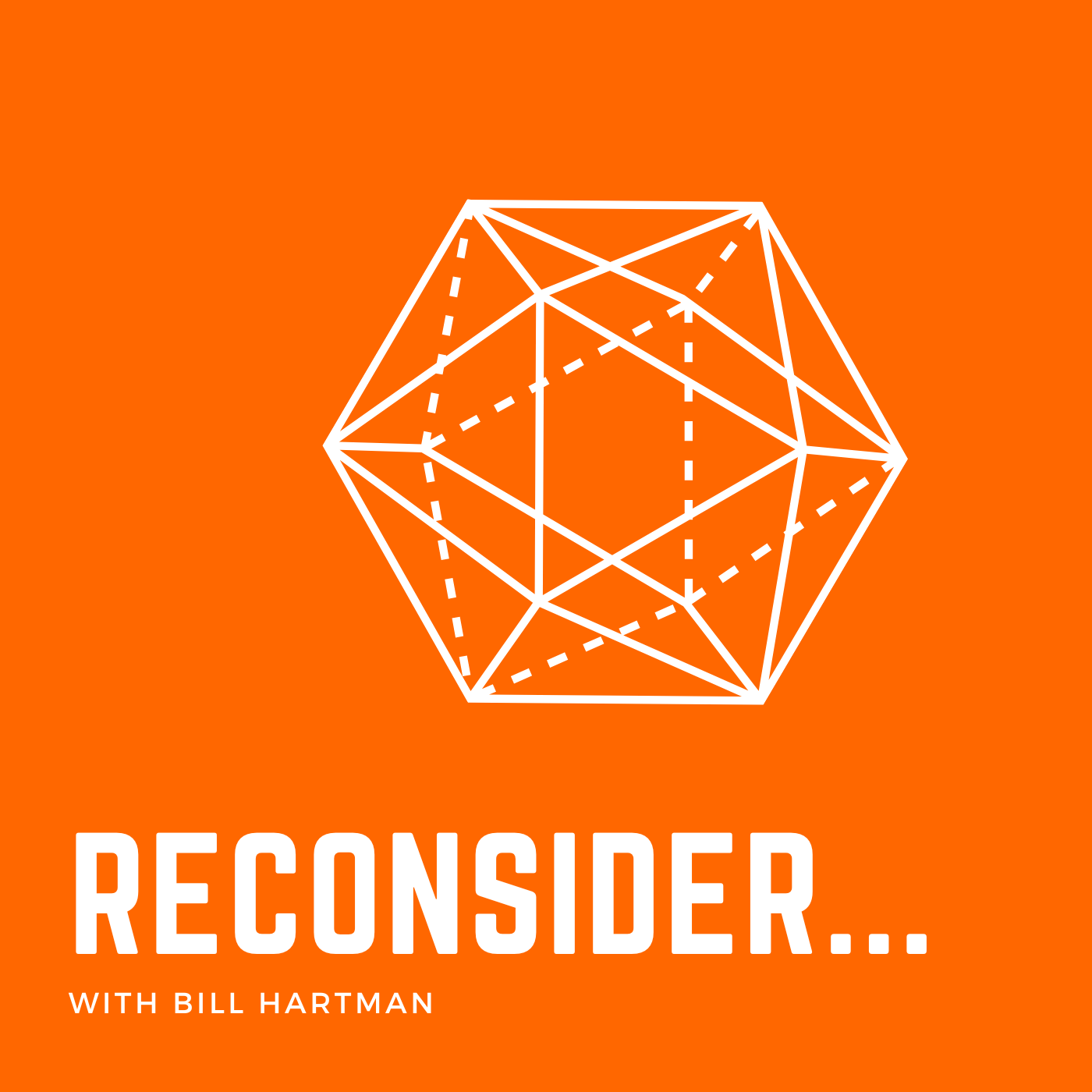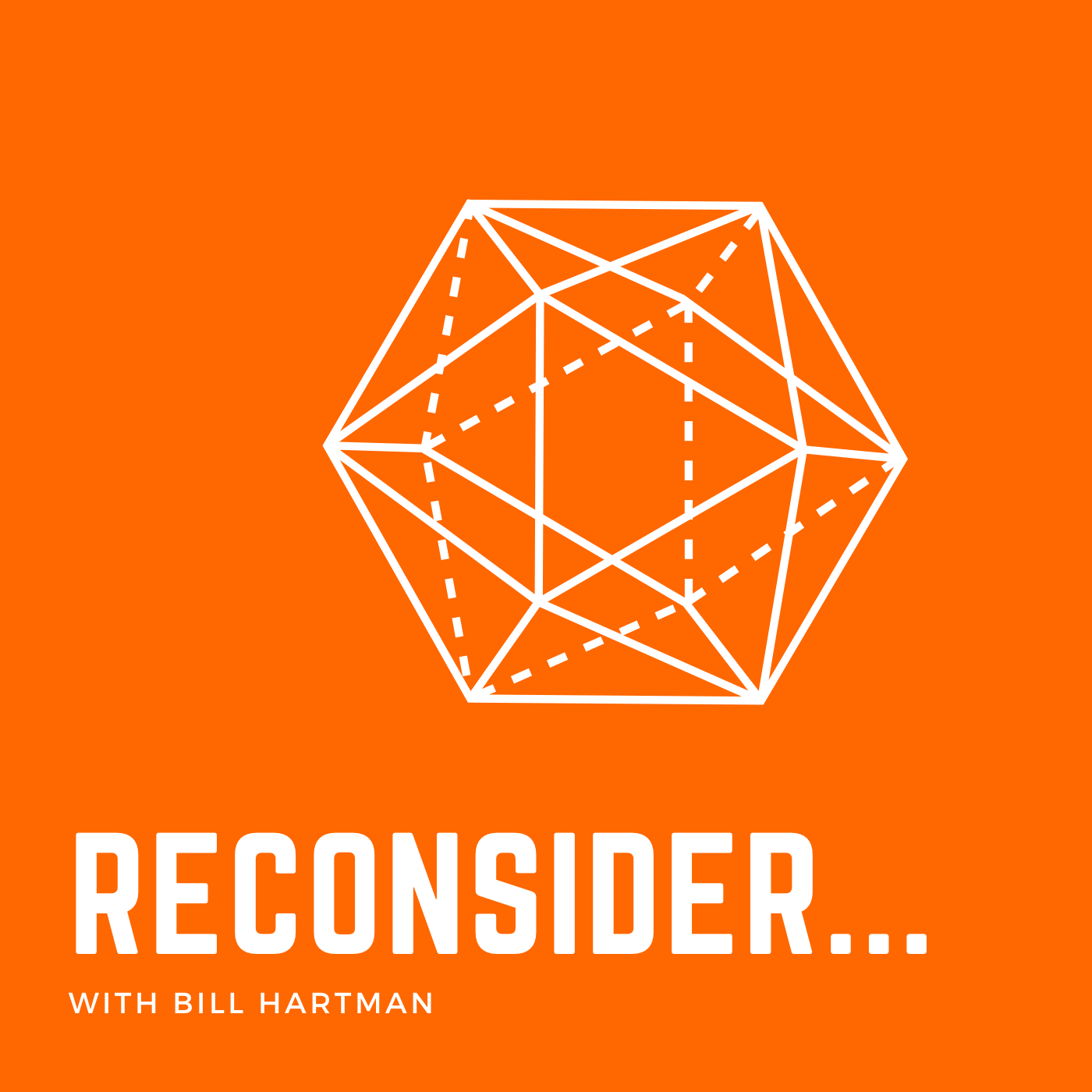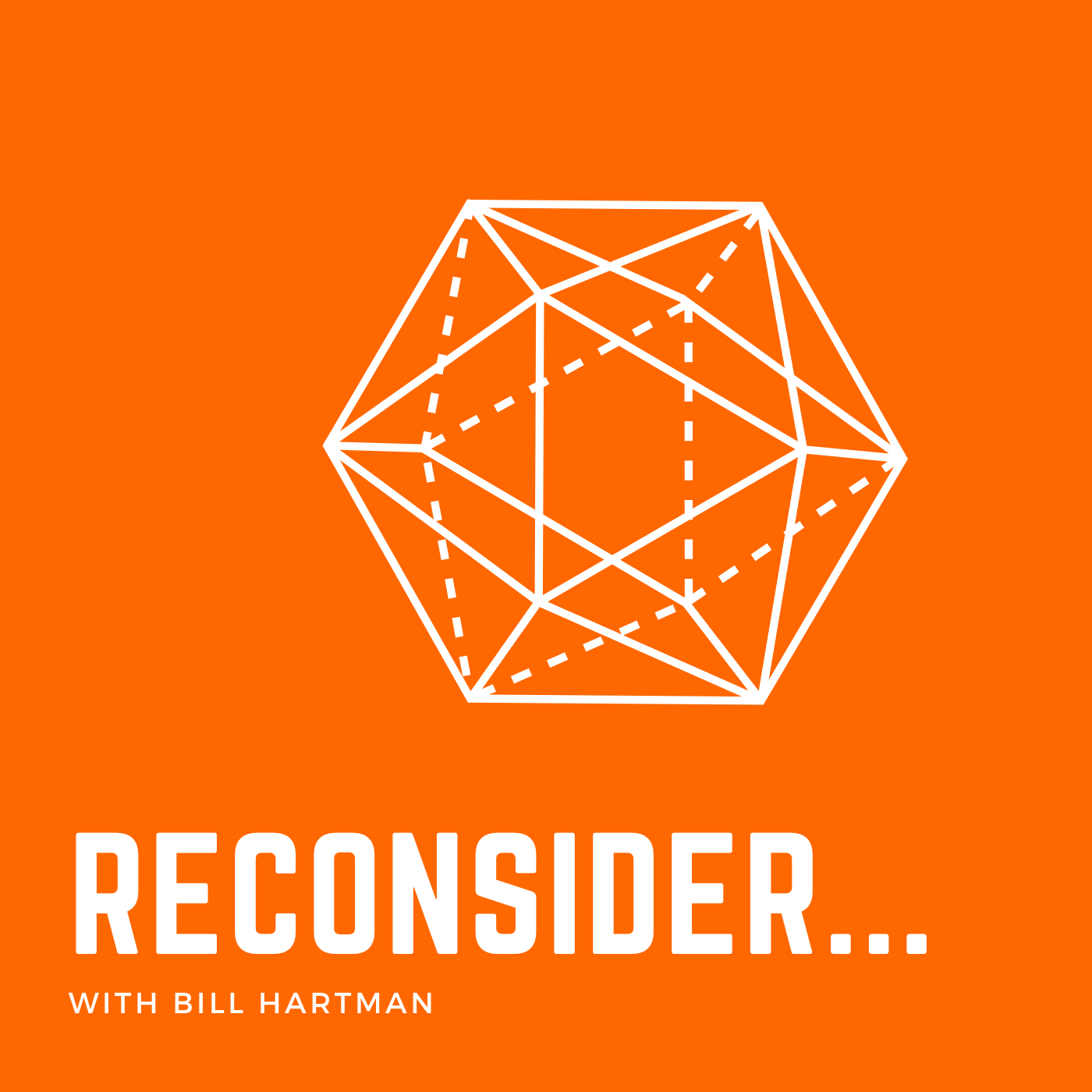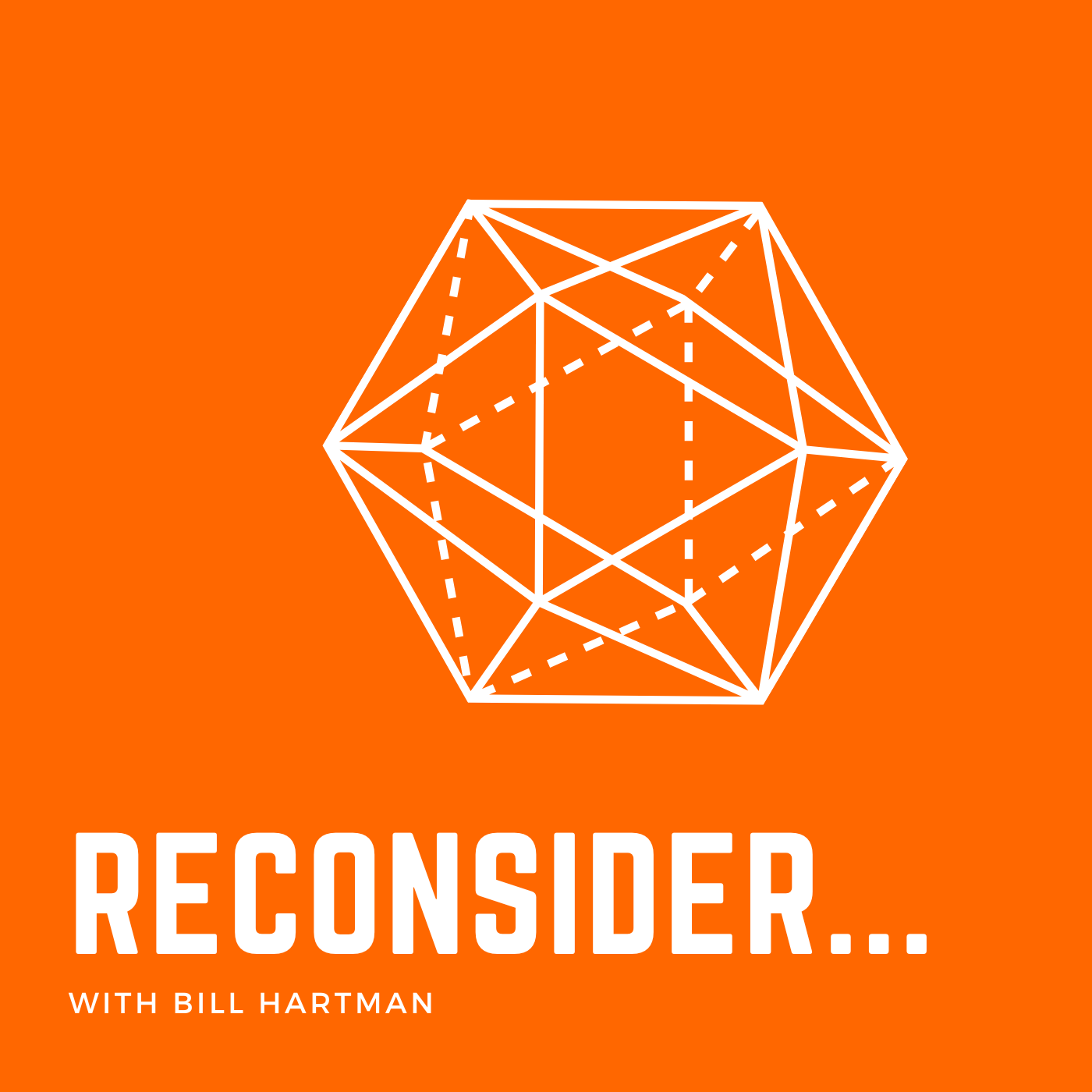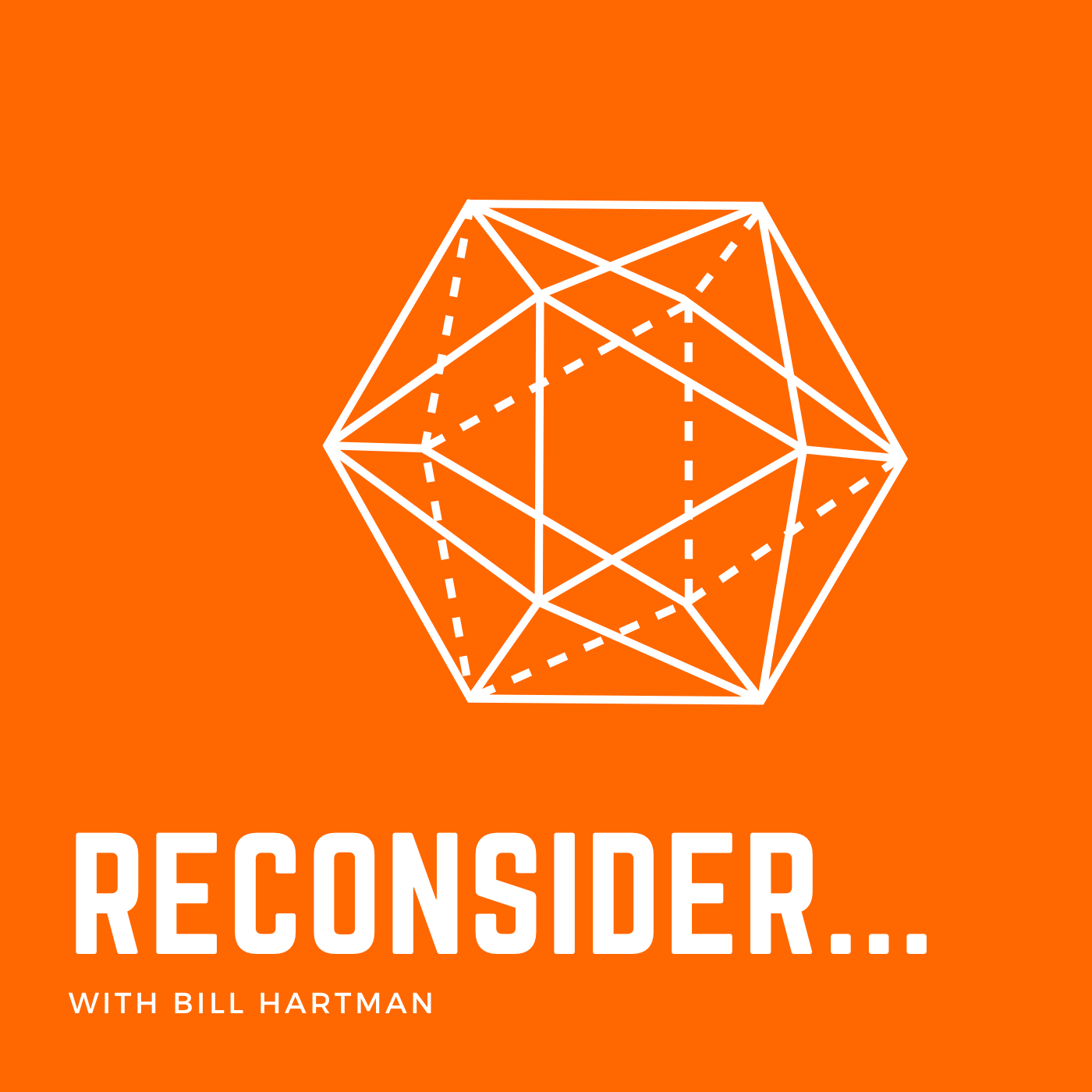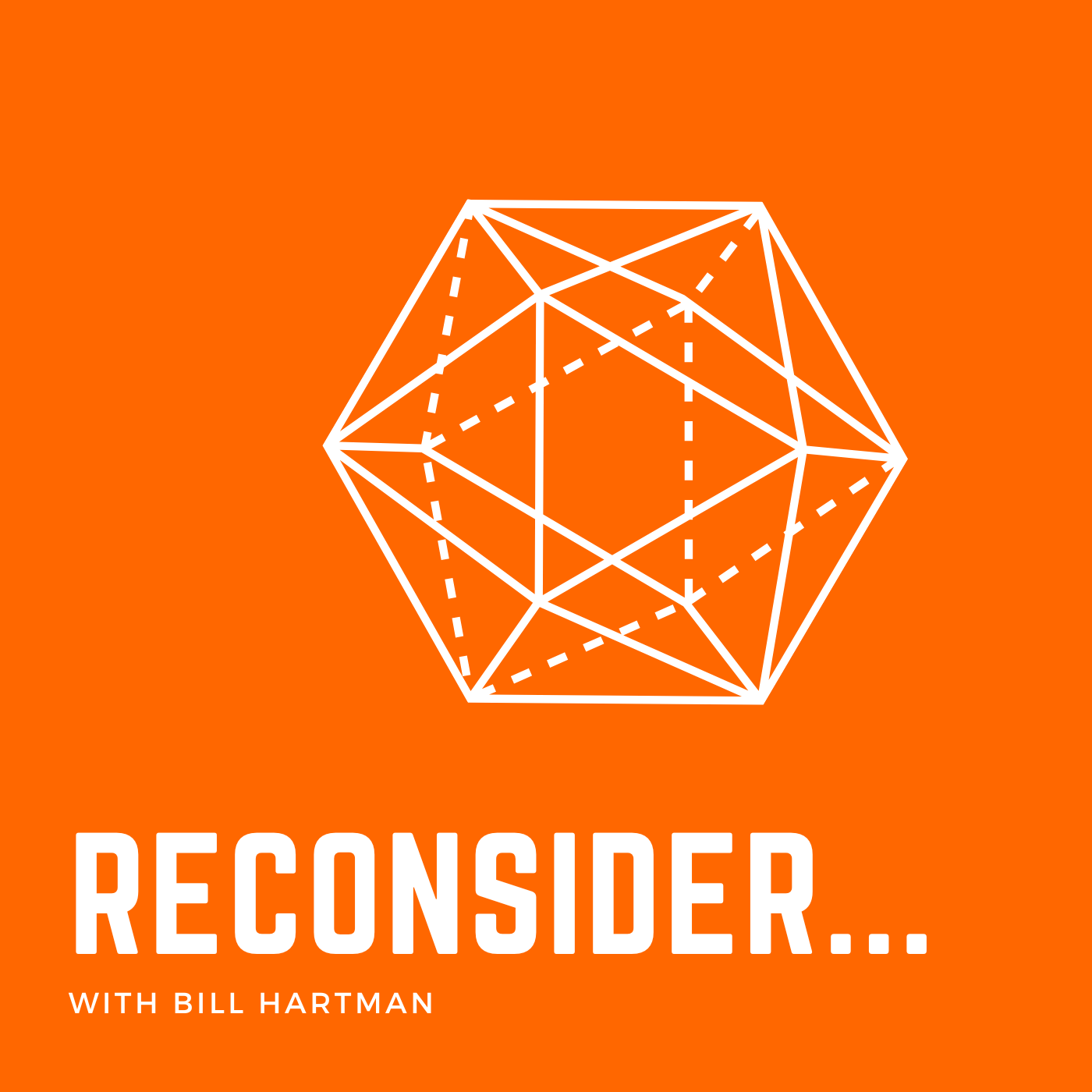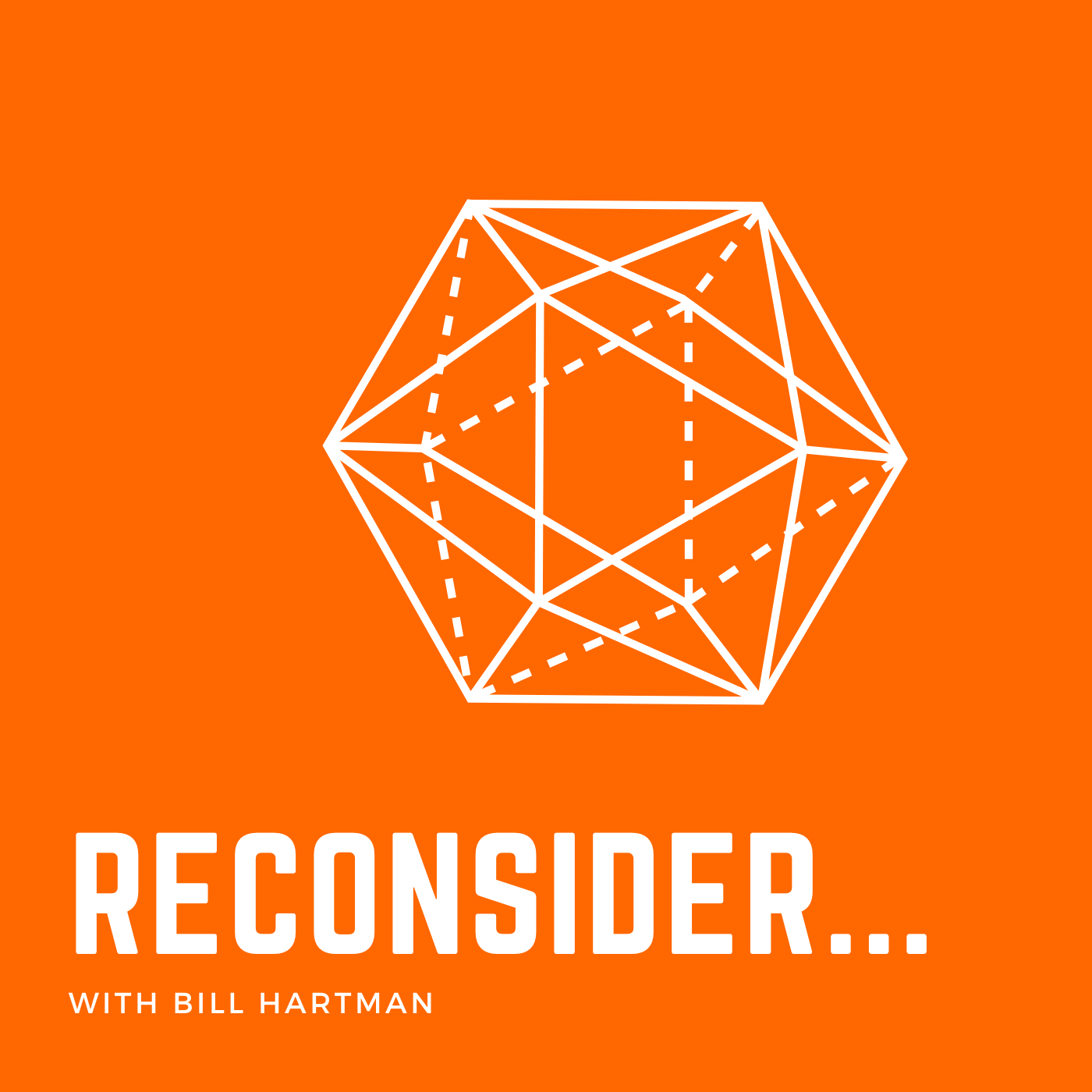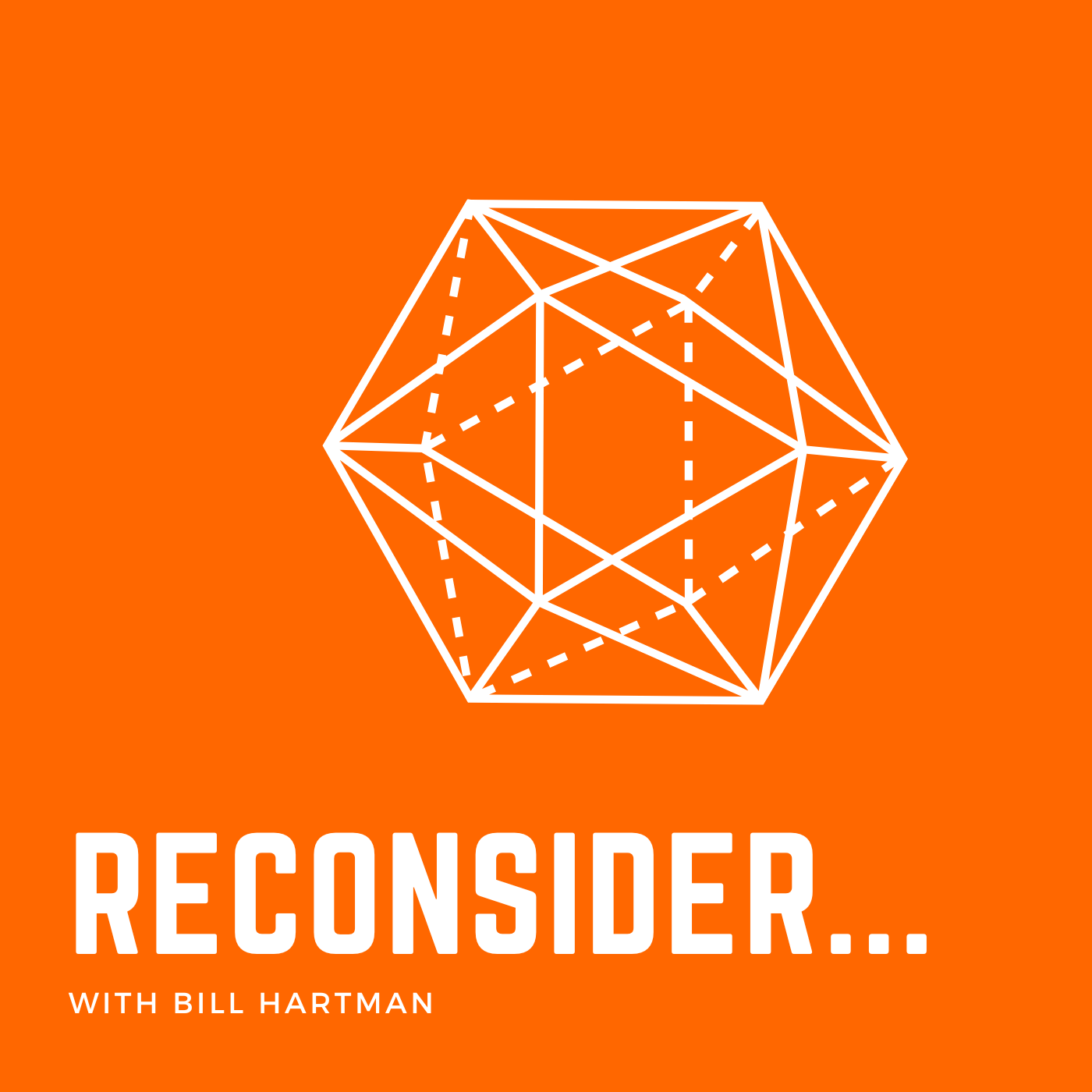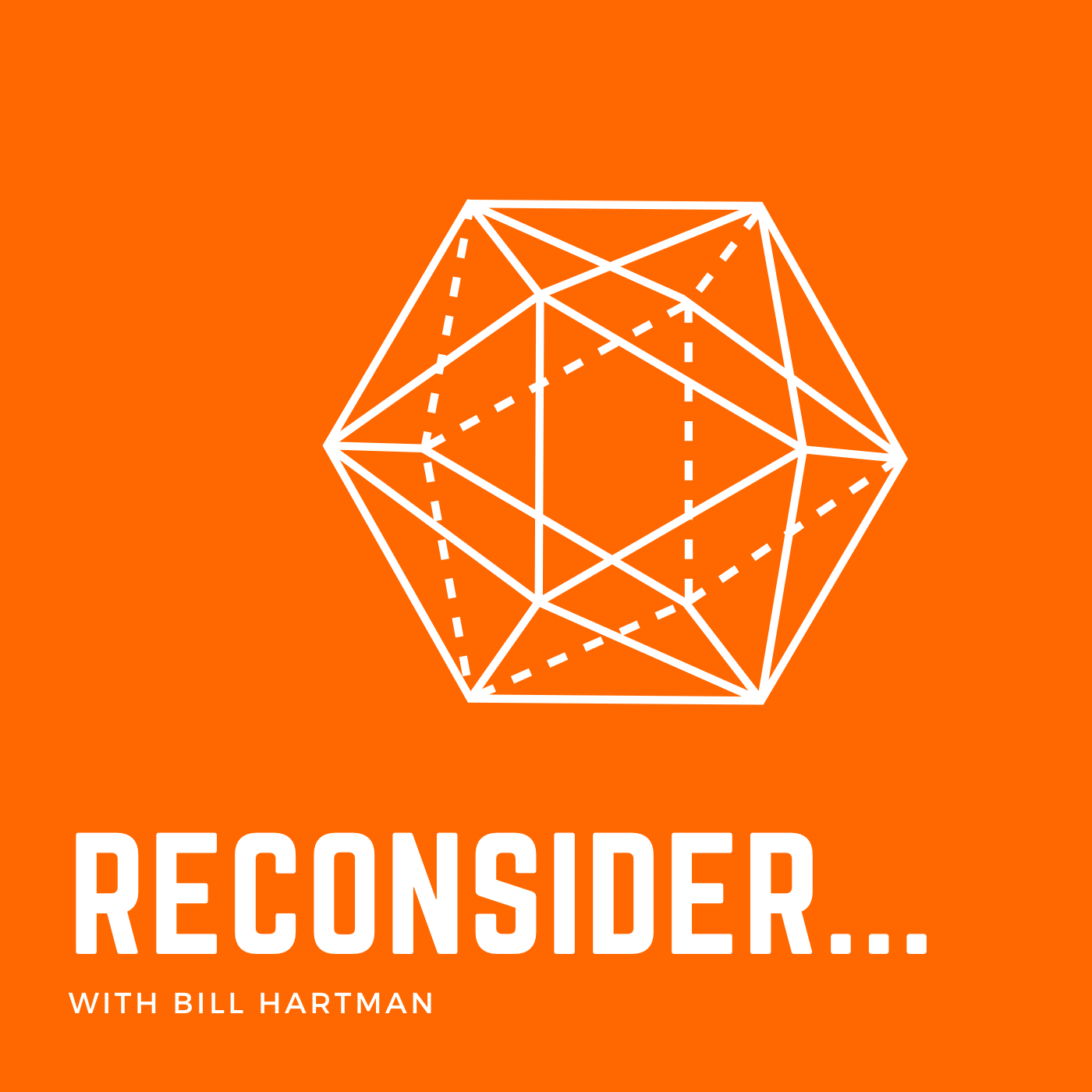Discover RECONSIDER with Bill Hartman
RECONSIDER with Bill Hartman

RECONSIDER with Bill Hartman
Author: Bill Hartman
Subscribed: 7Played: 191Subscribe
Share
© Bill Hartman 2023
Description
Health. Wellness. Fitness. Getting in shape. We talk about such things based on mental models we evolve from our exposure to information, our limited understanding, and what we think is best. RECONSIDER with Bill Hartman will ask better questions to allow you to filter the good to promote better decisions when it comes to your choices of exercise and type of workout you perform at home, on the field, or in the gym. RECON will explore where some of the false beliefs about what, why, and how which exercise is best for your needs to get away from what often holds you back from making the changes and progress you desire.
75 Episodes
Reverse
Stop guessing with assessments. Start learning from the source.Free courses and the new Assessment 101 are waiting for you: http://UHP.networkThink you know how to assess a squat? Think again.In this episode, Bill Hartman and Chris dismantle the myth of “squat as pattern” and show you how to actually use squats as diagnostic behavior. The focus is on propulsion, internal rotation, and how the system expresses its real strategy.You’ll never look at a butt wink, heel lift, or shift the same way again.What You’ll LearnWhy squats are not universal patterns. They are outputs of constraintHow to read internal rotation within a squatWhy “fixing form” can remove the evidence you're looking forHow propulsion phases show up during descent and returnWhy ramps, heel lifts, and load are strategic resistanceThe difference between limitation and protective behaviorHow to connect squat behavior with table test findingsWhy “stance” language confuses what is actually happeningEpisode Timestamps 00:00 – Squatting Isn’t a Pattern 01:26 – Strategy Over Shape: Reading the Squat 03:48 – Stop Over-Coaching: Let Behavior Speak 06:13 – Observation over Correction: How to Set It Up 09:05 – Shifts, Reach, and Posterior Orientation 11:44 – Complex Movements Mirror the Table Tests 14:19 – Squatting as Phases of Propulsion 17:34 – Manipulating Propulsion with Constraints 20:34 – Strategic Resistance: Ramps, Heels, and Load 25:35 – Goblet vs Plate Reach: IR Strategies in ActionAssessment 101 is coming soon to http://UHP.networkSign up now to get early access, plus these free resources:Model 101 CourseDecision-Making CoursePropulsive Anatomy IntroWeekly Q&A calls and content archive with UHP+ membershipStart learning the UHPC Model from the source and make sense of your assessments.Stay ConnectedInstagram: https://www.instagram.com/bill_hartman_pt/Train with Bill: https://www.reconu.coPodcast on Spotify: https://open.spotify.com/show/7cJM6v5S38RLroac6BQjrdPodcast on Apple: https://podcasts.apple.com/us/podcast/reconsider-with-bill-hartman/id1662268221Website: https://billhartmanpt.com/📺 Subscribe on YouTube: https://www.youtube.com/@BillHartmanPT🔖 Hashtags#SquatAssessment #PropulsionPhases #StrategicResistance #UHPCModel #Biomechanics #InternalRotationMatters #AssessDontCorrect #MovementStrategy #StrengthCoach #HumanMovement
It is so much more than biomechanics… → Join http://UHP.network FREE to start learning.Not a pattern. Not a form. A strategy. This episode redefines everything you thought you knew about squatting — through the lens of the Unified Health & Performance Continuum (UHPC) Model.00:00 – Intro: Squat ≠ Pattern01:38 – Strategic Resistance Explained05:01 – Why Movement Patterns Fail07:06 – No Ideal, Just Strategy10:05 – Olympic Lifts & Deep Squat Variability13:29 – Squatting Through the Lens of Propulsion15:43 – Developmental Alignment: Babies & Broad Jumps17:14 – Forward Motion is the Only Motion20:17 – Containment vs. Reversal21:38 – Losing Early Propulsion = Rigid Squats22:48 – Wide Archetypes & Foot Position23:59 – Episode Wrap-Up: Not a Pattern24:13 – Bonus Question: What Are You Watching? Subscribe for more episodes that redefine movement through the UHPC Model. #Squat #UHPCModel #BillHartman #StrategicResistance #ShapeChange #ForwardMotion #MovementIsBehavior #CoachingBetterLEARN MOREJOIN the UHP Network to learn directly from Bill through articles, videos and courses.http://UHP.network FOLLOW Bill on IG to stay up to date on when his courses are coming out:IG: https://www.instagram.com/bill_hartman_pt/TRAIN WITH BILLInterested in the only training program based on Bill Hartman’s Model?Join the rapidly growing community who are reconstructing their bodies at https://www.reconu.co FREE EBOOK by Bill about the guiding principles of training when you fill out your sign-up form. http://www.reconu.co SUBSCRIBE for even more helpful content:YT: https://www.youtube.com/@BillHartmanPTIG: https://www.instagram.com/bill_hartman_pt/Podcast audio:https://open.spotify.com/show/7cJM6v5S38RLroac6BQjrd?si=eca3b211dafc4202https://podcasts.apple.com/us/podcast/reconsider-with-bill-hartman/id1662268221or download with YT Premium
"You’re Not Measuring What You Think: Movement Screens, Compensations, and Energetic Behavior" → Join http://UHP.network FREE to start learning.Episode OverviewBill and Chris explore how complex movements—like squats, toe touches, and turns—serve as energetic assessments within the UHPC Model. Gravity, pressure, and shape govern what you see. The episode walks through real examples, including a breakdown of the Apley Scratch Test, showing how misinterpreted motions can still offer useful information if understood through shape and phase.Key Topics & Chapter Highlights00:00 – Complex Movements vs Traditional Screens01:30 – The Value of Table Tests in Interpreting Behavior03:45 – How Gravity Uncovers Hidden Constraints06:00 – The Scratch Test Misconception08:30 – Movement Is Always Strategy10:30 – Squats and Toe Touches as Energetic Windows12:45 – When and Why People Can’t Access Motion15:00 – Rotation Tests and Propulsion Phases20:00 – Real-World Application and the Problem with Labels30:00 – Final Thoughts and Coffee OrdersKey TakeawaysMovement screens don’t test joints—they reveal strategies.Clean table measures don’t guarantee upright performance.The Apley Scratch Test shows IR on both sides, not ER vs IR.Compensation is not dysfunction—it’s a strategy.Squats, toe touches, and turns are behavioral probes, not mobility checks.Labels like “IR-deficient” often miss the deeper systemic constraint.If you don’t understand what you’re seeing, you can’t intervene effectively.LEARN MOREJOIN the UHP Network to learn directly from Bill through articles, videos and courses.http://UHP.network FOLLOW Bill on IG to stay up to date on when his courses are coming out:IG: https://www.instagram.com/bill_hartman_pt/TRAIN WITH BILLInterested in the only training program based on Bill Hartman’s Model?Join the rapidly growing community who are reconstructing their bodies at https://www.reconu.co FREE EBOOK by Bill about the guiding principles of training when you fill out your sign-up form. http://www.reconu.co SUBSCRIBE for even more helpful content:YT: https://www.youtube.com/@BillHartmanPTIG: https://www.instagram.com/bill_hartman_pt/FB: https://www.facebook.com/BillHartmanPTWEB: https://billhartmanpt.com/Podcast audio:https://open.spotify.com/show/7cJM6v5S38RLroac6BQjrd?si=eca3b211dafc4202https://podcasts.apple.com/us/podcast/reconsider-with-bill-hartman/id1662268221or download with YT Premium
Episode OverviewBill and Chris unpack the philosophy and implementation of assessment within the UHPC Model, showing how testing reveals energetic behavior—not just structural position. Rather than focusing on static joint angles, they illustrate how relative motion, systemic organization, and phase-based strategies tell the real story of what a system can or cannot do. The discussion critiques isolative and reductionist interpretations and offers a coherent, propulsion-informed approach to understanding and intervening effectively.Key Topics & Chapter Highlights00:00 – What Assessment Is For02:30 – You’re Probably Not Measuring What You Think You Are06:40 – What ER and IR Measures Actually Tell You09:10 – Relative Motion vs Orientation12:00 – Local Symptoms Are Global Behavior Problems14:00 – ER = Space | IR = Pressure16:30 – Table Tests Aren’t Neutral20:00 – Propulsion Phases Reveal the Strategy24:00 – The Tests Reveal Potential, Not Performance27:30 – Even If You Don’t Do Table Tests...Key TakeawaysAssessment reveals system behavior, not joint capacity.You’re always measuring shape, not parts.Table tests show potential, not upright readiness—but they’re foundational for interpreting strategy.Relative motion is key. Orientation without opposition means compression and less adaptability.IR = pressure. ER = space. Both are phase-dependent, not just joint-specific.Complex movements reflect strategy. Know what you’re seeing.No movement is neutral. Every behavior reflects an energetic solution—or a compensation.LEARN MOREJOIN the UHP Network to learn directly from Bill through articles, videos and courses.http://UHP.network FOLLOW Bill on IG to stay up to date on when his courses are coming out:IG: https://www.instagram.com/bill_hartman_pt/TRAIN WITH BILLInterested in the only training program based on Bill Hartman’s Model?Join the rapidly growing community who are reconstructing their bodies at https://www.reconu.co FREE EBOOK by Bill about the guiding principles of training when you fill out your sign-up form. http://www.reconu.co SUBSCRIBE for even more helpful content:YT: https://www.youtube.com/@BillHartmanPTIG: https://www.instagram.com/bill_hartman_pt/FB: https://www.facebook.com/BillHartmanPTWEB: https://billhartmanpt.com/Podcast audio:https://open.spotify.com/show/7cJM6v5S38RLroac6BQjrd?si=eca3b211dafc4202https://podcasts.apple.com/us/podcast/reconsider-with-bill-hartman/id1662268221or download with YT Premium
Free articles and courses about movement from Bill Hartman at http://uhp.networkEpisode Overview Bill and Chris delve into the detailed behavior of muscles as dynamic, context-sensitive tissues. They emphasize that muscles don’t simply contract or produce force but modulate tension, stiffness, and elasticity to support movement and structural integrity. #fitness #movement #muscle #health #physicaltherapy #strengthtraining Key Topics & Chapter Highlights 00:00 – Muscles as Adaptive Tissues02:50 – Tension and Stiffness Modulation06:10 – Phase-Specific Muscle Roles09:45 – Impact of Habitual Muscle Patterns13:20 – Elasticity’s Role in Movement Efficiency17:00 – Coordinating Breath and Muscle Tone20:00 – Muscle Behavior as Shape Change22:30 – Strategies to Restore Muscle ResponsivenessKey TakeawaysMuscle behavior is adaptive and context-dependent, not merely force production.Tension and stiffness are modulated to balance stability and mobility.Movement phases dictate differing muscle roles and timing.Habitual patterns reduce flexibility and movement options.Elasticity and breath coordination are essential for efficient muscle function.LEARN MOREJOIN the UHP Network to learn directly from Bill through articles, videos and courses.http://UHP.network FOLLOW Bill on IG to stay up to date on when his courses are coming out:IG: https://www.instagram.com/bill_hartman_pt/TRAIN WITH BILLInterested in the only training program based on Bill Hartman’s Model?Join the rapidly growing community who are reconstructing their bodies at https://www.reconu.co FREE EBOOK by Bill about the guiding principles of training when you fill out your sign-up form. http://www.reconu.co SUBSCRIBE for even more helpful content:YT: https://www.youtube.com/@BillHartmanPTIG: https://www.instagram.com/bill_hartman_pt/FB: https://www.facebook.com/BillHartmanPTWEB: https://billhartmanpt.com/Podcast audio:https://open.spotify.com/show/7cJM6v5S38RLroac6BQjrd?si=eca3b211dafc4202https://podcasts.apple.com/us/podcast/reconsider-with-bill-hartman/id1662268221or download with YT Premium
Learn the truth about health and performance from Bill Hartman at http://uhp.networkEpisode Overview Bill and Chris unpack the widespread misuse of “core training” — especially crunches — as a solution for back pain or a shortcut to aesthetics. They challenge the isolative logic behind ab-focused exercises, arguing that these strategies often reinforce compression, reduce movement options, and degrade systemic adaptability. Drawing from UHPC principles, they reframe the core not as a region to be strengthened, but as a dynamic interface for managing pressure, guiding shape change, and enabling forward propulsion. Crunches may feel productive, but they often compromise what the system truly needs: coherence. #coreworkout #fitness #physicaltherapy #movement #absworkout Key Topics & Chapter Highlights 00:00 – Crunches Reinforce the Problem01:20 – Segmental Training Misses the System04:00 – Compression Restricts Access06:00 – Creating Space vs. Forcing Downforce10:00 – What the “Core” Actually Does13:00 – Pressure ≠ Strength16:00 – Breath and Base Before Load20:00 – Trade-offs of Aesthetic Focus27:00 – A Coherent Core SequenceKey TakeawaysCrunches constrain, they don’t liberateCore muscles organize pressure, not aestheticsTrue training integrates breath, position, and propulsionMovement freedom is the ultimate measure of “core strength”LEARN MOREJOIN the UHP Network to learn directly from Bill through articles, videos and courses.http://UHP.network FOLLOW Bill on IG to stay up to date on when his courses are coming out:IG: https://www.instagram.com/bill_hartman_pt/TRAIN WITH BILLInterested in the only training program based on Bill Hartman’s Model?Join the rapidly growing community who are reconstructing their bodies at https://www.reconu.co FREE EBOOK by Bill about the guiding principles of training when you fill out your sign-up form. http://www.reconu.co SUBSCRIBE for even more helpful content:YT: https://www.youtube.com/@BillHartmanPTIG: https://www.instagram.com/bill_hartman_pt/FB: https://www.facebook.com/BillHartmanPTWEB: https://billhartmanpt.com/Podcast audio:https://open.spotify.com/show/7cJM6v5S38RLroac6BQjrd?si=eca3b211dafc4202https://podcasts.apple.com/us/podcast/reconsider-with-bill-hartman/id1662268221or download with YT Premium
Live Q&A Calls with Bill Hartman at http://uhp.networkEpisode Overview In this episode, Chris and Bill scrutinize the “Four Stages of Competence” model — a familiar framework in coaching and skill acquisition that assumes learners progress linearly from ignorance to mastery. This discussion reframes learning as a dynamic reorganization of behavior in response to constraint, not a climb up a competence ladder.Key Topics & Chapter Highlights00:00 – Why We’re Talking About “Learning”04:00 – The “Four Stages” Origin Story07:00 – Linearity vs. Complexity10:00 – “Incompetence” Isn’t Incompetent14:00 – Coaching Without Context Fails18:00 – Behavioral Recognition Over Labels23:00 – You’re Not Coaching a Blank Slate28:00 – The Limits of Cueing32:00 – Adaptive Behavior, Not Error36:00 – Evolving the Model (Again)41:00 – Interventions as Design, Not Correction45:00 – Wrapping Up: The System Solves ItselfKey Takeaways Movement — even if awkward or compensatory — reflects the best available solution to the system’s current constraints. That’s competence, just not your preferred version. Adaptation doesn’t follow steps. It unfolds in response to pressure, structure, and context. That process is inherently non-linear. Labels like “incompetent” blind us to what's actually happening. Watch what people do. Understand what it's solving for.Models Should Breathe Even the quadrant model evolved through testing. If your model isn’t helping you see clearly, evolve it — or discard it. LEARN MOREJOIN the UHP Network to learn directly from Bill through articles, videos and courses.http://UHP.network FOLLOW Bill on IG to stay up to date on when his courses are coming out:IG: https://www.instagram.com/bill_hartman_pt/TRAIN WITH BILLInterested in the only training program based on Bill Hartman’s Model?Join the rapidly growing community who are reconstructing their bodies at https://www.reconu.co FREE EBOOK by Bill about the guiding principles of training when you fill out your sign-up form. http://www.reconu.co SUBSCRIBE for even more helpful content:YT: https://www.youtube.com/@BillHartmanPTIG: https://www.instagram.com/bill_hartman_pt/FB: https://www.facebook.com/BillHartmanPTWEB: https://billhartmanpt.com/Podcast audio:https://open.spotify.com/show/7cJM6v5S38RLroac6BQjrd?si=eca3b211dafc4202https://podcasts.apple.com/us/podcast/reconsider-with-bill-hartman/id1662268221or download with YT Premium
Free articles and courses about movement from Bill Hartman at http://uhp.network Episode OverviewIn this episode, Chris and Bill take aim at the overused and under-defined concept of "core training." They unpack how the term has been inflated into a one-size-fits-all solution for pain, posture, and performance — without coherence or clarity. Key Topics & Chapter Highlights00:00 – Core as a Catch-All02:45 – The Problem with “Core Weakness”05:10 – What Does the Core Even Mean?08:00 – The Myth of Bracing11:25 – Structure Shapes Strategy14:50 – Breathing vs. Bracing17:30 – Positional Relevance20:20 – Rehab Defaults and Lazy Logic23:00 – A Better Question: What Is This Shape Solving For?26:15 – Core Emerges, It’s Not TargetedKey Takeaways“The Core” Lacks Coherence The term is too vague to be useful. It’s become a placeholder for problems we haven’t fully diagnosed.Bracing is Not the Answer Most core training uses bracing as a fix — but that often compresses options and distorts the system's ability to move.Breath Drives Support Coherent systems don’t stabilize through tension — they use pressure gradients, breath, and timing to support action.Structure Shapes Need Different archetypes demand different strategies. Core work that ignores structure will likely create conflict.Emergence Over Isolation Core integrity isn’t trained — it emerges when the system organizes itself well under load, direction, and breath.LEARN MOREJOIN the UHP Network to learn directly from Bill through articles, videos and courses.http://UHP.network FOLLOW Bill on IG to stay up to date on when his courses are coming out:IG: https://www.instagram.com/bill_hartman_pt/TRAIN WITH BILLInterested in the only training program based on Bill Hartman’s Model?Join the rapidly growing community who are reconstructing their bodies at https://www.reconu.co FREE EBOOK by Bill about the guiding principles of training when you fill out your sign-up form. http://www.reconu.co SUBSCRIBE for even more helpful content:YT: https://www.youtube.com/@BillHartmanPTIG: https://www.instagram.com/bill_hartman_pt/FB: https://www.facebook.com/BillHartmanPTWEB: https://billhartmanpt.com/Podcast audio:https://open.spotify.com/show/7cJM6v5S38RLroac6BQjrd?si=eca3b211dafc4202https://podcasts.apple.com/us/podcast/reconsider-with-bill-hartman/id1662268221or download with YT Premium
Free articles and courses from Bill Hartman at http://uhp.network Episode OverviewIn this episode, Chris and Bill deconstruct the idea of posture as a static ideal or diagnostic tool. Instead, they define posture as a real-time behavioral strategy. #posture #health #movement #fitness #physicaltherapy #lowbackpain Key Topics & Chapter Highlights00:00 – The episode opens with a challenge to the traditional view of posture as something to correct. Chris and Bill reframe it as behavior.05:30 – They differentiate posture as strategy, not structure. 09:45 – Why “Ideal Posture” Is a Myth14:10 – Posture doesn’t exist in isolation. The same shape can have different meanings depending on context.19:30 – You can’t “fix” posture without shifting the internal strategy.24:40 – From breathing to gaze, small behaviors contribute to posture. 30:10 – Chris and Bill warn that repetitive posture cueing may enforce rigidity. 36:25 – Real-world posture shows up most under pressure. 42:00 – Postures often labeled as “poor” — like slouching — may actually be protective strategies. 48:10 – They offer examples of how decoding posture — rather than correcting it.54:20 – Posture should be seen as “expressed strategy” — a dynamic behavior, not a fixed trait.Key TakeawaysPosture Is Behavior, Not Structure: There Is No Ideal: “Good” or “bad” posture misses the point. Suppressing a posture may block the system’s strategy without resolving the constraint.The goal is a system that can change shapes — not one that holds the “right” one.Ask: What is this posture solving for?LEARN MOREJOIN the UHP Network to learn directly from Bill through articles, videos and courses.http://UHP.network FOLLOW Bill on IG to stay up to date on when his courses are coming out:IG: https://www.instagram.com/bill_hartman_pt/TRAIN WITH BILLInterested in the only training program based on Bill Hartman’s Model?Join the rapidly growing community who are reconstructing their bodies at https://www.reconu.co FREE EBOOK by Bill about the guiding principles of training when you fill out your sign-up form. http://www.reconu.co SUBSCRIBE for even more helpful content:YT: https://www.youtube.com/@BillHartmanPTIG: https://www.instagram.com/bill_hartman_pt/FB: https://www.facebook.com/BillHartmanPTWEB: https://uhp.networkPodcast audio:https://open.spotify.com/show/7cJM6v5S38RLroac6BQjrd?si=eca3b211dafc4202https://podcasts.apple.com/us/podcast/reconsider-with-bill-hartman/id1662268221or download with YT Premium
Learn More From Bill Live on the UHP network http://UHP.networkEpisode OverviewChris and Bill critically examine the traditional “stretch what’s tight, strengthen what’s weak” model in movement and rehabilitation. They explore how this reductionist approach oversimplifies the complexity of human movement by focusing on isolated muscles rather than systemic behavior. #movement #fitness #stretching #physicaltherapy #health Key Topics & Chapter Highlights00:00 – IntroductionThe hosts introduce the topic by discussing the widespread belief that movement problems can be solved by stretching tight muscles and strengthening weak ones. 03:12 – Critique of ReductionismChris and Bill discuss how the popularity of the reductionist approach stems from its ease of teaching and comfort for both practitioners and clients. 08:40 – Historical Context and Systemic ThinkingThey review historical influences, such as PNF (Proprioceptive Neuromuscular Facilitation) and osteopathic models, which originally emphasized systemic behavior and movement patterns but have since been reduced to isolated techniques.12:30 – The Reality of Stretching and StrengtheningThe hosts explore what actually happens during stretching and strengthening, noting that sensations of tightness are often related to connective tissue tension and body position rather than muscle length. They challenge the idea that stretching makes muscles longer and discuss the potential risks of overstretching.18:20 – Bone and Connective Tissue AdaptationChris and Bill explain that extreme flexibility in athletes is often due to bony and connective tissue adaptations, not just muscle lengthening. 23:50 – Strengthening and Movement BehaviorThe conversation shifts to strengthening, noting that perceived muscle weakness is often a result of body position and systemic constraints rather than isolated muscle deficits. The hosts emphasize that restoring movement options and body shape is more important than targeting individual muscles.30:00 – Case Examples and Clinical ReasoningPractical scenarios—such as hip flexor stretches and glute activation exercises—are discussed to illustrate how traditional interventions may provide temporary relief but fail to address underlying systemic issues. The hosts explain why some interventions work in some contexts but not others.40:15 – Signal vs. Noise in InterventionChris and Bill highlight the importance of reproducible, lasting changes versus temporary symptomatic relief. They encourage practitioners to look for systemic patterns and to avoid over-relying on isolated techniques.45:20 – The Bigger Picture: Adaptability and ConstraintsThe hosts stress that adaptations are context-dependent solutions, not inherently dysfunctional, and that effective intervention requires understanding the whole system.Key TakeawaysMovement and pain are systemic, emergent behaviors shaped by interacting forces and body shape changes, not just isolated muscle function.The “stretch what’s tight, strengthen what’s weak” model is an oversimplification that often fails, especially with complex cases.Sensations of tightness and weakness are often related to body position and systemic constraints, not just muscle length or strength.Extreme flexibility and perceived muscle tightness can result from bony and connective tissue adaptations, not just muscle behavior.Temporary symptomatic relief is not the same as lasting, systemic change; practitioners should look for reproducible, context-dependent improvements.
Free articles and courses about movement from Bill Hartman at http://uhp.network Episode 63 OverviewChris and Bill critically examine traditional motor control models in movement science, contrasting them with the Unified Health and Performance Continuum (UHPC) model. Their discussion challenges reductionist, brain-centric explanations of movement, advocating instead for an emergent, systems-based perspective that emphasizes adaptability, energy flow, and problem-solving in human movement. The episode is rich with practical analogies, clinical reasoning, and real-world examples to illustrate the limitations of conventional approaches and the strengths of the UHPC framework.Key Topics & Chapter Highlights00:00 – Introduction01:14 – Critique of Reductionism08:24 – Emergence and Complexity13:47 – Energy Flow and Gradients16:46 – Adaptation as Solution, Not Dysfunction18:19 – Integrating Tools, Rethinking Reasoning20:47 – Continuum of Health and Performance24:10 – Case Example: Knee Pain32:12 – Observation and Iteration33:53 – Systemic vs. Isolated SolutionsKey TakeawaysThe UHPC model views movement as an emergent, adaptive behavior shaped by energy flow, constraints, and systemic problem-solving-not just neural control or isolated muscle activation.Variability and adaptability are hallmarks of healthy movement; reductionist models that seek to eliminate variation can increase fragility.Practitioners should focus on expanding movement options and adaptability, using observation, questioning, and experimentation rather than rigid protocols.Structural adaptations are context-dependent solutions, not inherently dysfunctional.Effective clinical reasoning requires moving beyond static anatomical models and embracing complexity, energy dynamics, and the continuum between health and performance.Communication, curiosity, and willingness to question established paradigms are essential for practitioner growth and improved client outcomes.LEARN MOREJOIN the UHP Network to learn directly from Bill through articles, videos and courses.http://UHP.network TRAIN WITH BILLInterested in the only training program based on Bill Hartman’s Model?https://www.reconu.co SUBSCRIBE for even more helpful content:YT: https://www.youtube.com/@BillHartmanPTIG: https://www.instagram.com/bill_hartman_pt/FB: https://www.facebook.com/BillHartmanPTWEB: https://billhartmanpt.com/Podcast audio:https://open.spotify.com/show/7cJM6v5S38RLroac6BQjrd?si=eca3b211dafc4202https://podcasts.apple.com/us/podcast/reconsider-with-bill-hartman/id1662268221or download with YT Premium
Free articles and courses about ISA from Bill Hartman at http://uhp.network Episode Summary:In this episode, Chris and Bill explore the philosophical and practical foundations of the UHPC model, breaking down how it operates as a model, framework, and lens for clinical reasoning and movement assessment. The conversation is guided by AI-generated questions, prompting candid discussion on adaptation, structural change, practitioner bias, and the importance of communication and emotional intelligence in practice.Chapters:00:00 – Introduction and AI-Generated Questions01:14 – Model, Framework, and Lens: Definitions03:28 – Principles, Process, and Practices06:20 – Complexity, Probability, and Clinical Decision-Making08:01 – Structural Change vs. Compensation12:13 – Testing, Falsification, and Principles15:46 – Evolution of the Model and Embracing Failure19:23 – Measurement, Quantum Concepts, and Practitioner Bias22:38 – Handling Clinical Challenges and Uncertainty25:18 – Abductive Reasoning and Practitioner Improvisation27:55 – Emergent Failure, Communication, and the Human Element32:43 – Tracking Systemic Drift and Redirecting AdaptationKey Takeaways:The UHPC model is dynamic, functioning as a model, framework, and lens depending on context and scale.Clinical decision-making in complex systems is inherently probabilistic and iterative; outcomes emerge through intervention and observation.The model evolves through constant questioning, failure, and willingness to reframe assumptions.LEARN MOREJOIN the UHP Network to learn directly from Bill through articles, videos and courses.http://UHP.network FOLLOW Bill on IG to stay up to date on when his courses are coming out:IG: https://www.instagram.com/bill_hartman_pt/TRAIN WITH BILLInterested in the only training program based on Bill Hartman’s Model?Join the rapidly growing community who are reconstructing their bodies https://www.reconu.co FREE EBOOK by Bill about the guiding principles of training when you fill out your sign-up form. http://www.reconu.co SUBSCRIBE for even more helpful content:YT: https://www.youtube.com/@BillHartmanPTIG: https://www.instagram.com/bill_hartman_ptFB: https://www.facebook.com/BillHartmanPTWEB: https://billhartmanpt.comPodbaudio:https://open.spotify.com/show/7cJM6v5S38RLroac6BQjrd?si=eca3b211dafc4202https://podcasts.apple.com/us/podcast/reconsider-with-bill-hartman/id1662268221
Free articles and courses about ISA from Bill Hartman at http://uhp.network Try Bill’s training program based on YOUR ISA at http://www.reconu.co Episode Summary:In this episode, Chris and Bill continue their discussion on the Infra-Sternal Angle (ISA), diving deeper into how to identify and assess it, the implications of narrow vs. wide archetypes, and how this understanding can guide more individualized movement and training strategies. They demystify common misconceptions, clarify measurement expectations, and highlight how structural biases affect both breathing and performance potential.Chapters:00:00 – Introduction to the ISA Discussion01:14 – Clarifying Archetype Confusion01:59 – The Helical Nature of the ISA04:30 – Biases of Wide vs. Narrow Archetypes05:19 – Measuring the ISA: Article and Video Resource06:13 – Hands-On Expectations with Narrows08:40 – Hands-On Expectations with Wides10:39 – Assessing Intervention Impact on Relative Motion12:23 – Limitations of Clinical Populations13:36 – Table Measure Differences in Narrows and Wides17:12 – Training Considerations by Archetype18:37 – Training Risks for Narrows20:20 – Training Risks for Wides21:50 – Compression vs. Expansion in Both Archetypes23:03 – Episode Wrap-Up and ISA TakeawaysKey Takeaways:ISA is a Helical Concept: Not a flat-plane angle, and shouldn't be oversimplified.Structural Biases Matter: Narrows compress well and struggle to expand; wides expand easily but struggle to compress.Movement Assessment Requires Nuance: Table measures should be understood through the lens of structural archetypes.Training Should Be Archetype-Specific: Optimizing performance and minimizing compensation starts with matching intervention to structure.Avoid Overcompensation: Excessive training that aligns too strongly with a person’s structural bias can reduce variability and create new limitations.LEARN MOREJOIN the UHP Network to learn directly from Bill through articles, videos and courses.http://UHP.network FOLLOW Bill on IG to stay up to date on when his courses are coming out:IG: https://www.instagram.com/bill_hartman_pt/TRAIN WITH BILLInterested in the only training program based on Bill Hartman’s Model?Join the rapidly growing community who are reconstructing their bodies at https://www.reconu.co FREE EBOOK by Bill about the guiding principles of training when you fill out your sign-up form. http://www.reconu.co SUBSCRIBE for even more helpful content:YT: https://www.youtube.com/@BillHartmanPTIG: https://www.instagram.com/bill_hartman_pt/FB: https://www.facebook.com/BillHartmanPTWEB: https://billhartmanpt.com/
Free articles and courses about ISA from Bill Hartman at http://uhp.network Try Bill’s training program based on YOUR ISA at http://www.reconu.co Episode Summary:In this episode, Chris and Bill explore the concept of the Infra-Sternal Angle (ISA), discussing its definition, historical context, and implications for movement and performance. #isa #physicaltherapy #stretching #mobility #biomechanics Chapters & Timestamps:00:00 – Introduction to the Infra-Sternal Angle00:41 – Historical Context and Early Exposure04:26 – Defining the Infra-Sternal Angle08:27 – Structural Archetypes: Narrow and Wide09:02 – Movement and Breathing Biases15:00 – Performance Implications23:05 – Wide Structural Archetype Capabilities25:29 – Force vs. Velocity27:02 – ConclusionKey Takeaways:Understanding Structural Archetypes: Recognize the narrow and wide archetypes and their implications for movement.Breathing and Movement Biases: Each archetype has specific breathing and movement biases that influence performance.Performance Optimization: Tailor training strategies to the individual's structural archetype for optimal performance.Force vs. Velocity: Understand that force and velocity are distinct, with different archetypes excelling in each area.Books Mentioned in the Episode:Diagnosis and Treatment of Movement Impairment Syndromes: https://amzn.to/44b57oM LEARN MOREJOIN the UHP Network to learn directly from Bill through articles, videos and courses.http://UHP.network FOLLOW Bill on IG to stay up to date on when his courses are coming out:IG: https://www.instagram.com/bill_hartman_pt/TRAIN WITH BILLInterested in the only training program based on Bill Hartman’s Model?Join the rapidly growing community who are reconstructing their bodies at https://www.reconu.co FREE EBOOK by Bill about the guiding principles of training when you fill out your sign-up form. http://www.reconu.co SUBSCRIBE for even more helpful content:YT: https://www.youtube.com/@BillHartmanPTIG: https://www.instagram.com/bill_hartman_pt/FB: https://www.facebook.com/BillHartmanPTWEB: https://billhartmanpt.com/Podcast audio:https://open.spotify.com/show/7cJM6v5S38RLroac6BQjrd?si=eca3b211dafc4202https://podcasts.apple.com/us/podcast/reconsider-with-bill-hartman/id1662268221or download with YT Premium
Fix your pelvis with Bill’s RECON program at http://www.reconu.co Free articles and courses from Bill Hartman at http://uhp.network Episode Summary:In this episode, Chris and Bill delve into the complexities of anterior pelvic tilt, discussing its definition, common misconceptions, and effective management strategies. Chapters & Timestamps:00:00 – Introduction to Anterior Pelvic Tilt01:07 – Definition of Anterior Pelvic Tilt vs. Orientation04:17 – Biomechanical Considerations05:31 – Why Posterior Orientation Isn’t the Answer11:10 – Causes of Anterior Pelvic Orientation13:34 – Traditional Perspectives and Misconceptions19:04 – Reconsidering Stretching and Strengthening21:58 – Solutions: Reducing Muscle Activity and Managing Center of Gravity28:27 – They summarize the discussion, emphasizing the importance of understanding pelvic mechanics.Key Takeaways:Understanding Pelvic Mechanics: Distinguish between pelvic tilt and orientation to address issues effectively.Center of Gravity Management: Reducing muscle activity and managing the center of gravity are crucial for correcting anterior pelvic orientation.Exercise Strategies: Utilize exercises that promote relative motion and manage the center of gravity, such as reclined squats and elevated goblet squats.Avoiding Misconceptions: Traditional stretching and strengthening methods may not address the root cause of anterior pelvic orientation.LEARN MOREJOIN the UHP Network to learn directly from Bill through articles, videos and courses.http://UHP.network FOLLOW Bill on IG to stay up to date on when his courses are coming out:IG: https://www.instagram.com/bill_hartman_pt/TRAIN WITH BILLInterested in the only training program based on Bill Hartman’s Model?Join the rapidly growing community who are reconstructing their bodies at https://www.reconu.co FREE EBOOK by Bill about the guiding principles of training when you fill out your sign-up form. http://www.reconu.co SUBSCRIBE for even more helpful content:YT: https://www.youtube.com/@BillHartmanPTIG: https://www.instagram.com/bill_hartman_pt/FB: https://www.facebook.com/BillHartmanPTWEB: https://billhartmanpt.com/Podcast audio:https://open.spotify.com/show/7cJM6v5S38RLroac6BQjrd?si=eca3b211dafc4202https://podcasts.apple.com/us/po
Free articles and courses from Bill Hartman at http://uhp.network Episode Summary:In this episode, Chris and Bill explore the nuances of arm training, moving beyond traditional bodybuilding aesthetics to discuss how arm exercises can influence overall body positioning and movement. Chapters & Timestamps:00:00 – Introduction to Arm Training01:19 – Traditional vs. Strategic Arm Training03:06 – Mechanical Considerations in Arm Training04:19 – Case Study: Using Arm Exercises for Posture Correction08:00 – Position of Load and Center of Gravity09:03 – Negative Consequences of Traditional Arm Training12:42 – Analogies to Lower Body ExercisesKey Takeaways:Strategic Use of Arm Exercises: Arm training can be used to correct posture and improve movement beyond aesthetic goals.Mechanical Considerations: Understanding how arm exercises affect body mechanics is crucial for effective training.Load Positioning: Altering the position of the load can significantly impact movement outcomes.Analogies to Lower Body: Upper and lower body exercises can achieve similar mechanical effects on posture and movement.LEARN MOREJOIN the UHP Network to learn directly from Bill through articles, videos and courses.http://UHP.network FOLLOW Bill on IG to stay up to date on when his courses are coming out:IG: https://www.instagram.com/bill_hartman_pt/TRAIN WITH BILLInterested in the only training program based on Bill Hartman’s Model?Join the rapidly growing community who are reconstructing their bodies at https://www.reconu.co FREE EBOOK by Bill about the guiding principles of training when you fill out your sign-up form. http://www.reconu.co SUBSCRIBE for even more helpful content:YT: https://www.youtube.com/@BillHartmanPTIG: https://www.instagram.com/bill_hartman_pt/FB: https://www.facebook.com/BillHartmanPTWEB: https://billhartmanpt.com/Podcast audio:https://open.spotify.com/show/7cJM6v5S38RLroac6BQjrd?si=eca3b211dafc4202https://podcasts.apple.com/us/podcast/reconsider-with-bill-hartman/id1662268221or download with YT PremiumReconsider… is sponsored by Substance Nutritionhttps://substancenutrition.com/A healthy brain requires a healthy body. Why not take care of both all at once by using Synthesis protein and Neuro Coffee? Use code RECON at checkout to get free shipping on all of your orders
Learn More Directly From Bill Hartman FREE at http://uhp.network Episode Summary:In this episode, Bill and Chris dive into shoulder mobility, debunking common myths and explaining how breathing, pressure, and thoracic expansion impact movement. Key Takeaways:✅ Mobility is about accessing positions, not just increasing range of motion.✅ Your hips directly impact your shoulders—fix your pelvis first!✅ Foam rolling for shoulders isn’t the same as for hips—understand the difference.✅ Breathing & thoracic expansion are crucial for unlocking movement.✅ Rolling drills help restore true mobility more than passive stretching.Chapters & Timestamps:00:00 – Intro & Recap01:25 – What is Shoulder Mobility?04:00 – The Real Cause of Shoulder Restrictions06:30 – Why Shoulder Mobility Starts at the Hips10:55 – The Problem with Traditional Mobility Measures14:00 – The Role of Gravity & Breathing in Shoulder Mobility19:00 – The Truth About Foam Rolling for the Shoulder24:00 – The Best Shoulder Mobility Drills30:00 – Long-Axis Rolling: The Ultimate Test35:00 – Fun Closing Segment: Classic MTV Music Videos 🎵LEARN MOREJOIN the UHP Network to learn directly from Bill through articles, videos and courses.http://UHP.network FOLLOW Bill on IG to stay up to date on when his courses are coming out:IG: https://www.instagram.com/bill_hartman_pt/TRAIN WITH BILLInterested in the only training program based on Bill Hartman’s Model?Join the rapidly growing community who are reconstructing their bodies at https://www.reconu.co FREE EBOOK by Bill about the guiding principles of training when you fill out your sign-up form. http://www.reconu.co SUBSCRIBE for even more helpful content:YT: https://www.youtube.com/@BillHartmanPTIG: https://www.instagram.com/bill_hartman_pt/FB: https://www.facebook.com/BillHartmanPTWEB: https://billhartmanpt.com/LEARN: http://UHP.network Reconsider… is sponsored by Substance Nutritionhttps://substancenutrition.com/A healthy brain requires a healthy body. Why not take care of both all at once by using Synthesis protein and Neuro Coffee? Use code RECON at checkout to get free shipping on all of your orders
Learn More Directly From Bill Hartman FREE at http://uhp.network Episode Summary:In this episode, Bill and Chris discuss the common misconceptions surrounding hip mobility and the effectiveness of foam rolling. Key Takeaways:✔️ Mobility is more than stretching ✔️ Foam rolling works when done correctly ✔️ Diagnose before applying a solution ✔️ The Step-Over Drill is a game changer Chapters & Timestamps:00:00 – Introduction02:00 – Rethinking Mobility: More Than Just Stretching04:30 – The Role of Rotation in Joint Movement07:00 – Foam Rolling as a Mobility Tool11:00 – The Right Way to Use a Foam RollerRolling slower vs. rolling fast15:30 – Diagnosing Hip Mobility Issues18:00 – Step-by-Step Guide to Improving Hip Mobility23:00 – The Step-Over Drill for Hip MobilityTesting changes in hip mobility dynamically.26:00 – Final Thoughts: Why Traditional Mobility Drills May Not WorkStretching vs. shape changeLEARN MOREJOIN the UHP Network to learn directly from Bill through articles, videos and courses.http://UHP.network FOLLOW Bill on IG to stay up to date on when his courses are coming out:IG: https://www.instagram.com/bill_hartman_pt/TRAIN WITH BILLInterested in the only training program based on Bill Hartman’s Model?Join the rapidly growing community who are reconstructing their bodies at https://www.reconu.co FREE EBOOK by Bill about the guiding principles of training when you fill out your sign-up form. http://www.reconu.co SUBSCRIBE for even more helpful content:YT: https://www.youtube.com/@BillHartmanPTIG: https://www.instagram.com/bill_hartman_pt/FB: https://www.facebook.com/BillHartmanPTWEB: https://billhartmanpt.com/Podcast audio:https://open.spotify.com/show/7cJM6v5S38RLroac6BQjrd?si=eca3b211dafc4202https://podcasts.apple.com/us/podcast/reconsider-with-bill-hartman/id1662268221or download with YT PremiumReconsider… is sponsored by Substance Nutritionhttps://substancenutrition.com/A healthy brain requires a healthy body. Why not take care of both all at once by using Synthesis protein and Neuro Coffee? Use code RECON at checkout to get free shipping on all of your orders
Learn More Directly From Bill Hartman FREE at http://uhp.network SummaryThis episode delves into the intricacies of training methodologies, emphasizing the importance of intention behind exercises, the structure of training sessions, and the balance between performance and health. Chapters00:00 Understanding Training Session Structure04:46 The Importance of Intent in Training08:42 Warm-Up and Movement Preparation14:51 Phases of Propulsion in Training19:59 Exercise Selection and Health Considerations22:08 Understanding Back Pain and Recovery22:52 Revisiting Training Principles23:57 Practical Applications in Training25:33 Exercise Selection for Health Goals27:35 Balancing Performance and Health30:41 The Trade-offs in Powerlifting33:18 Refining Training Perspectives35:09 Nostalgia in Protein PowdersLEARN MOREJOIN the UHP Network to learn directly from Bill through articles, videos and courses.http://UHP.network FOLLOW Bill on IG to stay up to date on when his courses are coming out:IG: https://www.instagram.com/bill_hartman_pt/TRAIN WITH BILLInterested in the only training program based on Bill Hartman’s Model?Join the rapidly growing community who are reconstructing their bodies at https://www.reconu.co FREE EBOOK by Bill about the guiding principles of training when you fill out your sign-up form. http://www.reconu.co SUBSCRIBE for even more helpful content:YT: https://www.youtube.com/@BillHartmanPTIG: https://www.instagram.com/bill_hartman_pt/FB: https://www.facebook.com/BillHartmanPTWEB: https://billhartmanpt.com/Podcast audio:https://open.spotify.com/show/7cJM6v5S38RLroac6BQjrd?si=eca3b211dafc4202https://podcasts.apple.com/us/podcast/reconsider-with-bill-hartman/id1662268221or download with YT PremiumReconsider… is sponsored by Substance Nutritionhttps://substancenutrition.com/A healthy brain requires a healthy body. Why not take care of both all at once by using Synthesis protein and Neuro Coffee? Use code RECON at checkout to get free shipping on all of your orders
Take FREE courses to learn Bill’s UHPC Model http://uhp.network SummaryIn this episode, Chris and Bill delve into the complexities of pressure management in strength training, focusing on the use of weight belts and belly breathing techniques. Chapters00:00 Introduction to Pressure Management and Weight Belts02:46 Understanding the Physics of Cylinders and Spheres05:32 The Benefits of Weight Belts in Performance08:08 Negative Consequences of Weight Belt Use11:05 Belly Breathing vs. Weight Belts14:00 Reconsidering Breathing Techniques in Training16:47 Strategies for Safe Weight Belt Use19:50 Conclusion and Reflections on Training TechniquesLEARN MOREJOIN the UHP Network to learn directly from Bill through articles, videos and courses.http://UHP.network FOLLOW Bill on IG to stay up to date on when his courses are coming out:IG: https://www.instagram.com/bill_hartman_pt/TRAIN WITH BILLInterested in the only training program based on Bill Hartman’s Model?Join the rapidly growing community who are reconstructing their bodies at https://www.reconu.co FREE EBOOK by Bill about the guiding principles of training when you fill out your sign-up form. http://www.reconu.co SUBSCRIBE for even more helpful content:YT: https://www.youtube.com/@BillHartmanPTIG: https://www.instagram.com/bill_hartman_pt/FB: https://www.facebook.com/BillHartmanPTWEB: https://billhartmanpt.com/Podcast audio:https://open.spotify.com/show/7cJM6v5S38RLroac6BQjrd?si=eca3b211dafc4202https://podcasts.apple.com/us/podcast/reconsider-with-bill-hartman/id1662268221or download with YT PremiumReconsider… is sponsored by Substance Nutritionhttps://substancenutrition.com/A healthy brain requires a healthy body. Why not take care of both all at once by using Synthesis protein and Neuro Coffee? Use code RECON at checkout to get free shipping on all of your orders


